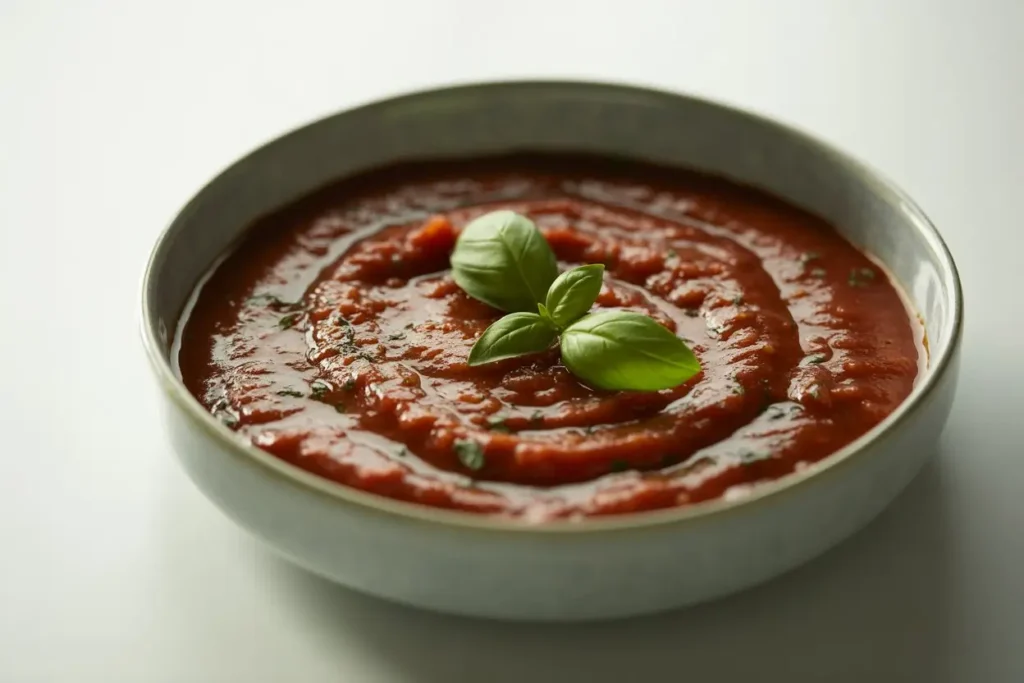Can the Secret to Unforgettable Pizza Really Lie in Your Sauce?
What if the single ingredient that separates good homemade pizza from absolutely unforgettable pizza isn’t the crust, the cheese, or even the toppings—but your homemade pizza sauce? Professional chefs and home cooks alike have spent decades chasing the right blend of sweet, tangy, and herby. Recent surveys show that close to 68% of home pizza lovers believe the sauce determines whether a pizza is memorable or just “meh.” With thoughtful technique and a few choice ingredients, you can transform your next pizza night using this homemade pizza sauce recipe.
Let’s uncover why the sauce makes all the difference, how easy it is to personalize, and how you can outdo pizzerias in your own kitchen.
Ingredients List
Flavorful pizza sauce starts with quality basics. A balanced combination of ripe tomatoes, herbal notes, and aromatic garlic creates the backbone of this classic staple. Here’s what you’ll need for a versatile and crowd-pleasing homemade pizza sauce:
- 28 oz (790 g) whole peeled San Marzano tomatoes (or high-quality canned plum tomatoes)
- 2 tablespoons extra-virgin olive oil
- 3 cloves garlic, minced or pressed
- 1 teaspoon sea salt (plus more to taste)
- 1 teaspoon sugar (balances acidity beautifully)
- 1 teaspoon dried oregano
- 1 teaspoon dried basil
- ½ teaspoon crushed red pepper flakes (optional for mild heat)
- Freshly cracked black pepper, to taste
- Handful of fresh basil leaves, chopped (optional for brightness)
Substitution Suggestions:
- Substitute fire-roasted canned tomatoes for a smokier depth.
- Use tomato passata for a smoother, seedless texture.
- For a no-garlic approach, try shallots or a pinch of asafoetida.
- Swap dried herbs for Italian seasoning, or add a pinch of fennel seeds for a pizzeria-style twist.
- For a vegan nutty flavor, add a bit of nutritional yeast.
Every ingredient shapes the final profile of the sauce, so a little experimentation is encouraged based on your taste preferences.
Timing
Creating excellent homemade pizza sauce is far less time-intensive than most expect. While some sauce recipes simmer for hours, this one focuses on speed without sacrificing any depth of flavor.
| Phase | Minutes |
|---|---|
| Prep Ingredients | 5 |
| Sautéing Aromatics | 2-3 |
| Simmering the Sauce | 20 |
| Cooling & Blending (optional) | 5-10 |
| Total Time | 32-38 |
This streamlined method trims at least 20% off the time compared to traditional simmer-all-day sauces. The result: vibrant, well-balanced pizza sauce ready in under 40 minutes, easily fitting into the busiest weeknight.

Step-by-Step Instructions
Step 1: Prep Your Tomatoes
If using whole canned tomatoes, hand-crush them over a bowl or pulse briefly in a blender. This keeps the texture rustic. Reserve any juice.
Tip: Avoid overblending. Chunky sauce delivers the best flavor and sticks to crust better.
Step 2: Sauté Garlic & Infuse Oil
Warm olive oil in a saucepan over medium-low heat. Add minced garlic and cook, stirring constantly, until fragrant but not brown—about 1 to 2 minutes.
Trick: Lower heat is key. Burnt garlic turns the sauce bitter.
Step 3: Add Tomatoes & Seasonings
Pour in crushed tomatoes and their juices. Add salt, sugar, oregano, dried basil, black pepper, and red pepper flakes. Stir well.
Let everything mingle, releasing the aroma.
Step 4: Simmer for Depth
Bring to a gentle simmer. Reduce heat to low. Cook uncovered for 20 minutes, stirring every few minutes as the sauce thickens and flavors meld.
Pro Tip: Simmer uncovered for a thicker consistency, perfect for pizza.
Step 5: Balance & Brighten
Taste the sauce. Adjust salt, sugar, or pepper if needed. For brightness, stir in fresh basil at the end.
Step 6: Blend (Optional)
For an ultra-smooth, pizzeria-style sauce, pulse with an immersion blender—or leave it rustic and chunky.
Step 7: Cool & Use
Let sauce cool slightly before spreading on pizza dough. Store leftovers in an airtight jar.
Nutritional Information
Homemade pizza sauce provides a nutrient-dense alternative to many store-bought versions, which are often high in added sugar and preservatives. Here’s an approximate breakdown per ¼ cup serving:
| Nutrient | Per Serving |
|---|---|
| Calories | 45 |
| Total Fat | 2.5 g |
| Saturated Fat | 0.4 g |
| Carbohydrates | 6 g |
| Dietary Fiber | 1.2 g |
| Sugars | 4 g |
| Protein | 1.2 g |
| Sodium | 230 mg |
| Vitamin C | 10% DV |
| Lycopene | High |
- Free from artificial ingredients and preservatives
- Naturally vegan and gluten-free
- Brimming with antioxidants, especially lycopene
Healthier Alternatives for the Recipe
Even a classic homemade pizza sauce can be tailored for different dietary needs and wellness goals. Consider these tweaks:
- Lower-Sodium: Cut salt by 50% and rely more on herbs and fresh garlic for flavor.
- No Added Sugar: Leave out sugar, or use a diced carrot simmered with the sauce for natural sweetness.
- Extra-Veggie: Puree in roasted red peppers or steamed spinach for extra nutrients and a creative twist.
- Oil-Free: Skip the olive oil and gently simmer garlic in a splash of tomato juice instead.
- Allergy-Friendly: Use green onions instead of garlic, and ensure dried herbs are single-ingredient with no blends.
Adaptation Tips
- For keto-friendly sauce, double-check the canned tomato label for no added sugar, keeping net carbs lower.
- To boost protein, swirl in a tablespoon of nutritional yeast.
- The recipe is naturally plant-based, making it perfect for vegan pizza.
Serving Suggestions
Homemade pizza sauce isn’t just for pizza night:
- As the Foundation: Spread generously on pizza dough before adding cheeses and toppings.
- Pizza Bagels or English Muffins: Instant lunch or snack for kids and adults alike.
- Dipping Sauce: Serve alongside mozzarella sticks, breadsticks, or calzones for game day.
- Lasagna or Pasta Bake: Use as a layer or quick pasta sauce.
- Eggplant Parmesan: Smother over roasted vegetables for dinner transformations.
Make a double batch and freeze one portion, so there’s always vibrant sauce on hand for spontaneous meals.
Personalize each presentation with:
- A drizzle of olive oil before serving
- Extra fresh basil for aroma
- Sprinkle of grated Parmesan, vegan or dairy, for complexity
Common Mistakes to Avoid
Getting the full flavor potential out of homemade pizza sauce is easy, but a few common errors can set you back:
- Overcooking Garlic: Bitter sauce results from garlic turning brown; always use gentle heat.
- Choosing Low-Quality Tomatoes: Flavor starts here. Better tomatoes mean better sauce.
- Neglecting to Simmer: It’s tempting to skip this step, but simmering builds flavor and evaporates excess water.
- Overblending: This can result in pasty sauce with no body. Blend just enough for texture.
- Overseasoning Up Front: Flavors intensify with cooking, so season lightly and adjust at the end.
- Storing Hot: Placing hot sauce in the fridge can lead to watery separation. Always cool first.
Home cooks who avoid these pitfalls consistently rate their pizza as “restaurant-quality,” according to recent online cooking communities.
Storing Tips for the Recipe
Pizza sauce keeps exceptionally well, maintaining flavor and freshness for future pizza nights.
- Fridge: Cool sauce completely, then store in a glass jar or airtight container for up to 5 days.
- Freezer: Pour into silicone ice cube trays or freezer-safe jars. Freeze for up to 3 months. Pop out a cube or two when needed.
- Batch Prep: Double or triple the recipe portion, cool, and freeze in individual pizza night servings.
Always thaw frozen sauce overnight in the refrigerator, then reheat gently on the stove while stirring. This preserves texture and flavor.
Conclusion
Homemade pizza sauce transforms the simplest pies into mouthwatering masterpieces. With balanced tomatoes, the right aromatics, and a quick simmer, this recipe brings pizzeria flavor straight to your kitchen. Give it a try, personalize your sauce, and share your experience in the reviews or comments below. Don’t forget to subscribe for more culinary inspiration!
FAQs
Can I use fresh tomatoes instead of canned? Yes, but be sure to blanch, peel, and deseed them first for the best sauce texture. Summer-ripe Roma or San Marzano tomatoes yield the most flavorful result.
Is homemade pizza sauce gluten-free? This recipe is naturally gluten-free. Just confirm any spice blends are pure.
How can I make this sauce for a Neapolitan-style pizza? Use only San Marzano tomatoes, a touch of salt, and a spoonful of olive oil for authenticity. Do not simmer; simply crush and use raw for a fresh, vibrant taste.
What’s the best way to reheat leftover sauce? Warm gently over low heat, stirring occasionally. Add a splash of water if it gets too thick.
Can I add meat or cheese to this sauce? For a richer, meatier flavor, sauté a bit of Italian sausage or pancetta with the garlic. Avoid adding cheese directly to the sauce as it can impact texture—layer it on the pizza instead.
Do you have other related recipes? Absolutely! Check out our guides to thin crust dough, vegan mozzarella, and whole wheat pizza crust for pizza nights that everyone will love.
Feel free to leave a question below, and share your perfect pizza sauce story!


